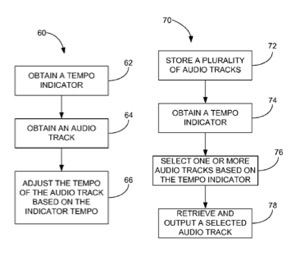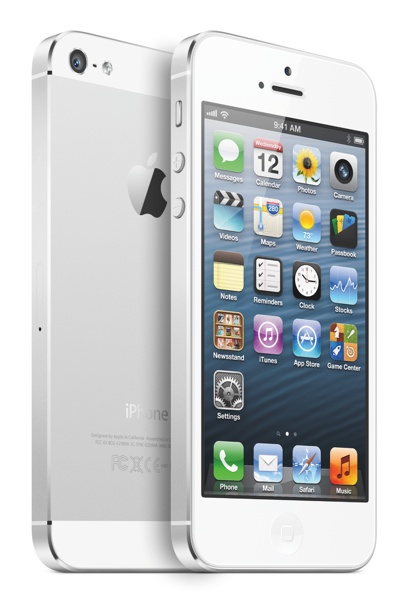An Apple patent (number 7973231) has popped up at the US Patent & Trademark Office for a music synchronization arrangement. The invention generally pertains to a hand-held computing device.
More particularly, the invention pertains to a computing device that is capable of controlling the speed of the music so as to affect the mood and behavior of the user during an activity such as exercise. By way of example, the speed of the music can be controlled to match the pace of the activity (synching the speed of the music to the activity of the user) or alternatively it can be controlled to drive the pace of the activity (increasing or decreasing the speed of the music to encourage a greater or lower pace). One aspect of the invention relates to adjusting the tempo (or some other attribute) of the music being outputted from the computing device.
By way of example, a songs tempo may be increased or decreased before or during playing. Another aspect of the invention relates to selecting music for outputting based on tempo (or some other attribute). For example, the computing device may only play songs having a particular tempo. Yet another aspect of the invention relates to both selecting music based on tempo and adjusting the tempo of the music. Adam Bowen is the inventor.
Here’s Apple’s background and summary of the invention: “There exist today many styles of sound machines such as home stereos, car stereos, boom boxes, CD players, and hand-held music players (e.g., MP3) for outputting music. Hand-held music players in particular have become increasingly popular as they allow a user to listen to music on the go. That is, because of their size, they can easily be transported wherever the user travels. In some cases, the devices are attached to the user, as for example, using a belt or clip, thereby making them even easier to transport.
“In fact, because of their ease of transport, they are commonly used when exercising. The user can wear the music player thereby leaving their hands free to exercise. The iPod, manufactured by Apple Inc. of Cupertino, Calif. is one example of a hand-held MP3 player.
“In most cases, the music stored in music player is downloaded from a host device such as a personal computer. The personal computer can include music management software that allows a user to sort, store and catalog their music. More particularly, the music management software gives the user the ability to organize their music into playlists, play music, purchase music over the Internet (World Wide Web), run a visualizer to display the music in a visual form, encode or transcode music into different audio formats such as MP3, AIFF, WAV, AAC, and ALE, and transfer music between the personal computer and the music players. iTunes, manufactured by Apple Inc. of Cupertino, Calif. is one example of music management software.
“A personal computer may also include other software programs associated with music. By way of example, the personal computer may utilize recording software that allows a user to perform, record and create music. These types of programs typically include features such as instruments, pre-recorded loops, amps, effects and editing tools. GarageBand, manufactured by Apple Inc. of Cupertino, Calif., is one example of a music recording program.
“The personal computer may also utilize mixing software that allows a user to perform DJ mixing, live remixing, and mix recording using music in various formats such as MP3. This type of software typically performs many functions including mixing, equalizing, cross fading, looping, tempo determination, pitch and tempo adjustment, etc. In order to synchronize two songs during mixing, mixing programs may be configured to analyze the music files and create beat marks for each song (annotate all the beats of the songs so that they can be matched efficiently during mixing).
“Furthermore, in order to adjust the tempo of a song without affecting pitch, mixing programs may utilize a technique called phase vocoding, which is one of the more powerful methods of manipulating sounds in the frequency domain. Only recently have personal computers had sufficient processing to make real-time phase vocoding a viable proposition. In the past, algorithms for phase vocoding were of such complexity and personal computers were of limited processing power such that it would often require many hours of processing to acquire each second of audio output. Traktor DJ Studio 2.0 manufactured by Native Instruments of Germany is one example of a mixing program.
Although music player systems utilizing a music player and personal computer work well, there is a continuing need for improved features for managing and outputting music.
“The invention relates, in one embodiment, to a music method performed on a hand-held computing device. The method generally includes designating an attribute of a song. The method also includes controlling the music output of the computing device based on the designated attribute of the song. The attribute may, for example, correspond to the tempo of the song.
“The invention relates, in another embodiment, to a method performed on a hand-held computing device. The method includes designating a tempo. The method also includes adjusting the tempo of one or more audio tracks being outputted to match the designated tempo.
“The invention relates, in another embodiment, to a method performed on a hand-held computing device. The method includes storing a plurality of audio tracks. Each audio track having a tempo. The method also includes designating a tempo. The method further includes selecting audio tracks from storage with a tempo similar to the designated tempo.
“The invention relates, in another embodiment, to a computer readable medium contained on a hand-held music player and including at least computer code for managing music. The medium includes obtaining the tempo of an event. The medium also includes outputting music. The medium further includes controlling the tempo of the music being outputted based on the tempo of the event.
The invention relates, in another embodiment, to a hand-held media player. The hand-held media player includes a housing of the media player. The hand-held media player also includes an accelerometer disposed inside the housing of the media player and configured to measure the motion of the media player. The hand-held music player further includes a music storage element disposed inside the housing of the media player and configured to contain one or more music items.
“The hand-held media player additionally includes a processor disposed inside the housing of the media player, and operatively coupled to the accelerometer and the music storage element. The processor is configured to control the output of the music items based on the motion of the media player.
“The invention relates, in another embodiment, to a method performed on a hand-held media player. The method includes sensing the pace of body motion. The method also includes playing one or more audio tracks. The method further includes adjusting the tempo of each audio track in accordance with changes in body motion.
“The invention relates, in another embodiment, to a method performed on a hand-held music player. The method includes designating a tempo profile. The method also includes outputting one or more audio tracks. The method further includes adjusting the tempo of the audio tracks based on the tempo profile.
“The invention relates, in another embodiment, to a method of transferring data between a host device and a portable media device. The portable media device is capable of storing and playing media items. The method includes, at the host device, designating at least one audio file for downloading to the portable media device. The method also includes, at the host device, generating a tempo tag for each designated audio file. Each tempo tag indicates the tempo of the audio file. The method further includes, at the host device, sending the audio file including the tempo tag to the portable media device.
“The invention relates, in another embodiment, to a method of transferring data between a host device and a portable media device. The portable media device is capable of storing and playing media items. The method includes, at the host device, designating at least one song for downloading to the portable media device. The method also includes, at the host device, producing a music collection for each designated song.
“Each music collection contains the original version of the designated song and new versions of the designated song. Each new version has a different tempo. The method further includes, at the host device, sending the music collection to the portable media device.
“The invention relates, in another embodiment, to an operational method for a hand-held music player. The method includes storing music data. The music data includes a plurality of music collections. Each music collection contains an original song and a plurality of differently formatted songs based on the original song. The original and differently formatted songs have different tempos.
“The music collection is generated separately on a device other than the portable media device. The method also includes designating a desired tempo. The method further includes retrieving at least one song from storage having a tempo that closely matches the desired tempo. The method additionally includes outputting one or more of the retrieved songs.
“The invention relates, in another embodiment, to a portable media device capable of playing music. The portable media device includes a storage device containing downloaded music data. The music data includes a plurality of music collections. Each music collection includes an original song and plurality of different versions of the original song. Each song in the music collection has an attribute with a different value. The portable media device also includes a processor configured to control the supply of songs to a speaker.”
— Dennis Sellers



